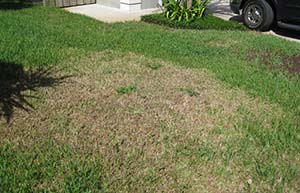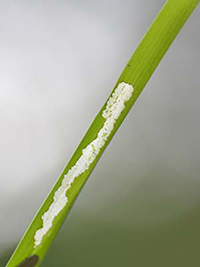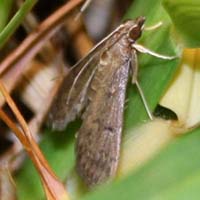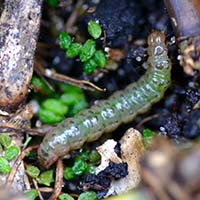Tropical Sod Webworm

Tropical sod webworm (Herpetogramma phaeopteralis) is one of the many pests that can damage your Florida lawn. While they prefer St. Augustinegrass, these very hungry caterpillars also munch on centipedegrass, bahiagrass, bermudagrass, and zoysiagrass. They are most active from spring to fall. Unfortunately, in South Florida, they can be found year-round.
Symptoms
The tropical sod webworm moths lay their eggs in turfgrass leaves. These light tan-colored moths will scatter as you walk through the grass. But it’s not the moths causing damage. The eggs hatch into larvae, also called caterpillars. This is the most damaging stage of the tropical sod webworm’s life-cycle. Mature caterpillars are ¾ to 1 inch long and grayish-green. (Interesting fact: the more grass they eat, the greener the caterpillars appear.)

Tropical sod webworm caterpillars feed at night, dawn, and dusk. During the heat of the day they rest, curled up below the blades. You may notice the signs of their destruction in your lawn before you see the pests themselves. An early sign of damage is “window feeding.” Window feeding is when the surface of the leaf tissue have been removed. The remaining tissue is almost clear, like a small window.
Later damage includes areas of ragged grass blades that are shorter than other areas of the grass. You may also spot piles of bright green caterpillar droppings. Eventually you will see thinning of the lawn (fewer blades) and brown patchy areas. Many gardeners report that the damage to their lawn seems to have occurred overnight. At this point, however, the caterpillars have likely been feeding for several days.
Prevention
Integrated pest management, or IPM, is a comprehensive approach to managing plant pests. IPM uses many different methods to reduce pests and maintain plant health while causing the least harm to people, property, and the environment.
Prevention is the first step in an IPM program. A healthy, well-maintained lawn will be less susceptible to tropical sod webworm damage. You can help keep your lawn healthy by properly mowing. If you choose to irrigate and fertilize, doing so correctly is key to maintaining your lawn’s health.

Another control strategy is to allow beneficial organisms to exist in your lawn. These predatory insects and spiders will help control sod webworms. While these species won’t eliminate the sod webworms entirely, they can keep populations from reaching damaging levels. To protect beneficial organisms, use pesticides as directed by the label, and only when necessary. Including many different kinds of plants in your landscape will also help support beneficial organisms.
Treatment
Of course, prevention is a moot point if you are already dealing with a pest problem. You may read that in some cases your lawn will recover from tropical sod webworm damage on its own. That is true — as long as your lawn is not suffering from any other type of stress. If your lawn is stressed, however, it may need your help.

Proper identification is a key step of IPM. Before you treat, first verify that you are in fact dealing with tropical sod webworms. You can send pictures or a turf sample to your county Extension office. Call your office for details.
Once you’ve correctly identified the pests as sod webworms, select a pesticide labeled for this particular pest. There are a number of pesticides you can buy at your local garden store. You can use the proper pesticides to spot-treat the affected areas following label instructions.
For more information about tropical sod webworm management, you can contact your county Extension office.
Also on Gardening Solutions
- Best Management Practices for Your Lawn
- Integrated Pest Management (IPM)
- Lawn Insect Pests
- Pesticide Safety: Application and Disposal
- St. Augustinegrass
